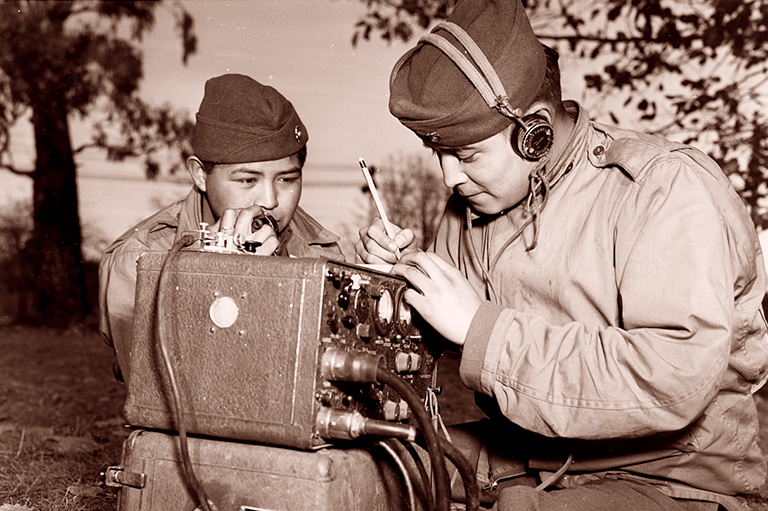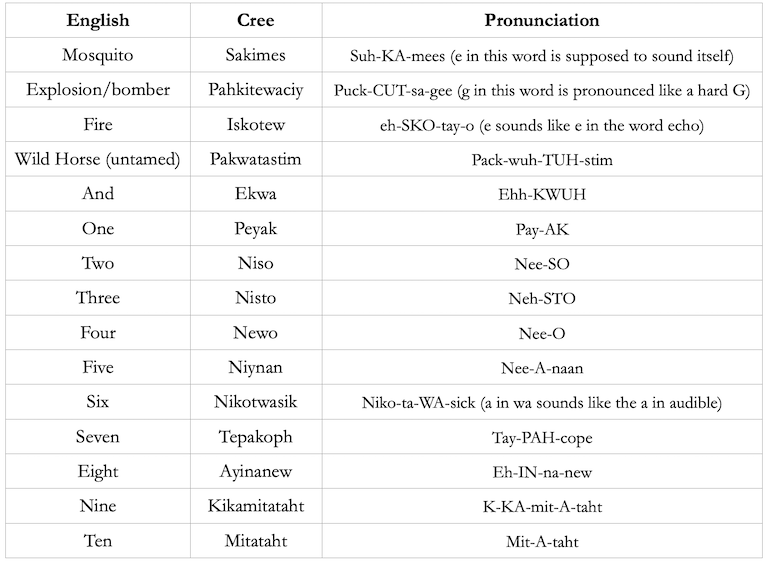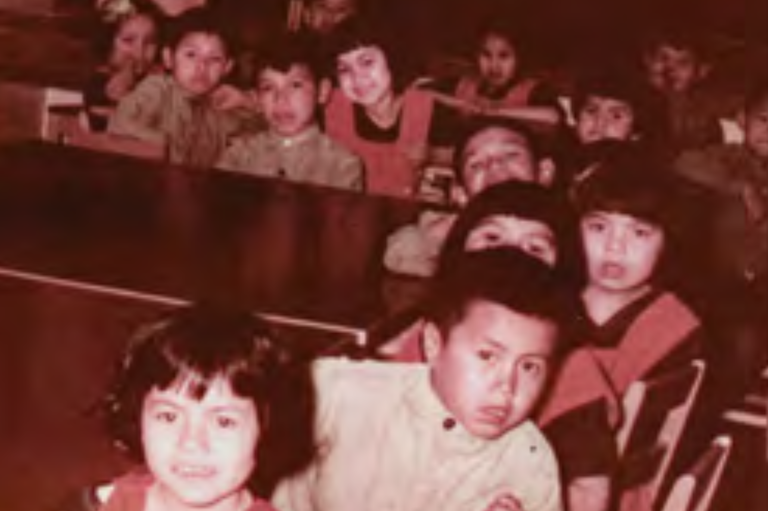Cree Code Talkers
Grade Levels: 3/4, 5/6, 7/8
Subject Area: Social Studies, Language
This lesson is inspired by the History Bits video “Wildfire.”
Lesson Overview
In the History Bits video “Wildfire” you will have learned about 1908 Olympian Tom Longboat and his service in the First World War. Longboat is widely considered to be one of Canada’s first celebrity athletes, receiving great success across North America and overseas. Many of the long-distance running training methods used today were developed and pioneered by Tom Longboat.
In this lesson, students will expand their knowledge and dive deeper into lesser-known Indigenous histories in Canada, particularly those of Second World War Cree Code Talkers. Students will then be asked to summarize and compare both histories.
What are Cree Code Talkers? What was their purpose?
During the Second World War, encryption and coded messages were deemed essential to winning the war and used on both sides of the conflict. It was imperative to use a code system that was unbreakable to the enemy to keep military positions, ammunitions, and operational plans hidden should the message be intercepted. The Canadian government came up with a clever way to encrypt messages from the Axis powers. Utilizing Cree, the government relied on Indigenous men to use their language to aid the war effort; these men were known as Cree Code Talkers. At the time, Cree was not a well-known language outside of North America. In the European theatre of war, transmitting messages in a rare language over the radio ensured encryption.
To the Cree people their language is often referred as Nehiyawewin and consists of five main dialects used throughout Turtle Island. The 5 dialects are:
- Plains Cree (known as the Y dialect)
- Woodlands Cree (known as the TH dialect)
- Swampy Cree (known as the N dialect)
- Moose Cree (known as the L dialect)
- Atikamekw Cree (known as the R dialect)1
These dialects are used in modern day Alberta, Saskatchewan, Manitoba, Ontario, and Quebec. Distinguishing the subtle to large differences within the language is significant. Many Code Talkers acknowledged throughout the war effort that when they were banded together to use their language as a tool of coding messages, they worked with other people of different dialects. This challenge was not exclusive to the Cree Code Talkers.
Who were some of the Cree Code Talkers? Were other languages used?
The European front was not the only area that utilized Indigenous peoples and languages to their advantage. The American government also employed Indigenous peoples to aid the war effort, using the Navajo people and their language in the Pacific theatre.

Charles Tomkins, a Métis Cree Code Talker from Grourd, Alberta, was enlisted in the secret operation while he was already in the army. He was chosen to participate in the operation of coding messages for the Air Force because of his extensive knowledge of both English and Cree. His parents taught him Cree from a young age and it was important to his family. He was tested on his Cree in London, England before joining the front.
Cree Code Talkers were sworn to secrecy during and after their involvement of the Second World War. Because of this, many Cree Code Talkers remained unknown to the public. Before his death, Charles Tomkins named several people that participated in the secret program. This included Walter McDermott, Peter Tomkins (Charles’ brother), John Smith (Charles’ half-brother) and Archie Plante (Charles’ friend). It is important to note that the people Charles named were from his home territory and spoke the same dialect.
Were they successful?
The simple answer is yes! Cree Code Talkers, as well as those who spoke other Indigenous languages such as Ojibwe, Comanche, and Navajo, were successful in coding messages without being discovered. Many of the Cree Code Talkers were tasked with coding messages for bombing runs and air missions.
Challenges Faced as a Cree Code Talker
Residential schools across Turtle Island were well established for many years preceding and during the Second World War. Indigenous children were sent to schools, often far away from their home territory and community, and forced to conform to Euro-centric ways of society. This included the forced assimilation of language and Indigenous culture, replaced with English and French and non-Indigenous ways of living.
It’s impossible to overstate the impact residential schools have had on Indigenous peoples in Canada. In this case, we can clearly see the intergenerational effect the school system had on Cree people and their language. Through the forced suppression of Indigenous languages, Cree became rare in the mid-20th century. The very reason Cree Code Talkers were successful — because their language was so rare — was a direct result of assimilation policies within Canada and within residential schools.
When the Second World War started, many Indigenous peoples did not join, as many of the treaties stated that they would not have to fight on behalf of the British Crown. This, however, was not realistic to every Indigenous person, and the growing need to provide for their families due to work shortages ultimately encouraged Indigenous peoples to join the war. It has been noted by many Indigenous veterans — not specifically Code Talkers — that they also joined the war to earn favour with non-Indigenous Canadians to have better opportunities after the war. This, however, was not the case. Throughout the years following the war, many Indigenous peoples felt the neglect and hardship from the society they had fought for, and that hardship was felt for many decades. The Canadian government only acknowledged the Cree Code Talkers in 1963 as the records became available. The Cree Code Talkers are still not widely known for their tremendous participation in the Second World War.
Activity 1
The Cree language does not have every specific English word to represent items and objects that were involved in the war. Because of this, the Cree Code Talkers had to be creative when using their language to code messages. In this way, the Cree Code Talkers had to repurpose their language and add context to the words. It is important to note that different dialects may use different spellings or words to describe the same object. In this activity, the Plains dialect (Y dialect) will be used and you will match the words to best describe the English object. You can download each photo with the link provided. You may wish to consult the pronunciation guide while teaching your students these words.
Example:
Mosquito — sakimes Explosion — pahkitewaciy
Together as Mosquito bomber — Sakimes pahkitewaciy

Teach your students these words as well:
- And — Ekwa
- One — Peyak
- Two — Niso
- Three — Nisto
- Four — Newo
- Five — Niyanan
- Six — Nikotwasik
- Seven — Tepakohp
- Eight — Ayinanew
- Nine — Kikamitataht
- Ten — Mitataht
Ask your students to make these words:
- 3 Spitfire
- 5 Mustangs
- 1 Mosquito bomber
- 2 Spitfire aircraft
Note that these “sentences” may not be grammatically correct. The aim is to introduce Cree as a language and its context to English and not necessarily to be completely correct. This is also a great opportunity to introduce numbers in Cree for everyday use!
You may wish to print out or display this pronunciation guide to help your students learn Cree words:

Activity 2
Task students to create a one paragraph summary (5-7 sentences) of their learning. Ensure that the summary includes the purpose of the Cree Code Talkers, where Cree is spoken in Turtle Island, and whether or not the Cree Code Talkers were a successful group. Feel free to have an open discussion regarding the use of language and the challenges that many Indigenous people faced at the time regarding the use of their language.
Activity 3
Ask your students to perform further research into Tom Longboat and Cree Code Talkers. Ask them to synthesize their research into a short written response comparing the experiences of Tom Longboat in beginning of the 20th century and his time in the First World War and as an athlete to that of the Cree Code talkers in the mid-20th century, before and after the Second World War.
Pose these questions to your students:
- In what ways are they similar or different?
- How should both Tom Longboat and Cree Code Talkers be recognized today?
- What impact did residential schools have in both these cases, if any?
Encourage them to consider the six historical thinking concepts in their answers.
Resources
- Cree Code Talkers, Canadian Encyclopedia
- The Tomkins Brothers interview, Canadian Encyclopedia
- How Cree Code Talkers From Alberta Helped Win the Second World War, Reader’s Digest Canada
- Indigenous Peoples and the First World War, Canadian Encyclopedia
Themes associated with this article
Advertisement




